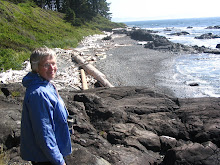 Image by // solidether via Flickr
Image by // solidether via Flickr
Yesterday I sat in the pouring rain for over three hours watching my team--the Saskatchewan Roughriders--play football. During our previous two home games in Regina, Saskatchewan, Canada, the temperatures hovered around 30 degree Celsius. We were cooking during those afternoon games. We had a misting spray bottle which we used to good effect. However, yesterday the misery was more of the cold and wet variety. As I sat at the game, I thought about community. I know that Rider Nation stretches far out from Taylor Field (now called Mosaic Stadium). All across Canada people are glued to their T.V.s, radios, and internet feeds to experience Rider games. When the Riders play in other cities in Canada, huge crowds of Rider fans sh
 ow up to cheer on their team. At some games, there are almost as many Rider fans at those games as there are fans for the home team. (Photo from http://www.saskriders.com/. "Fan of the game, Aug. 16/09)
ow up to cheer on their team. At some games, there are almost as many Rider fans at those games as there are fans for the home team. (Photo from http://www.saskriders.com/. "Fan of the game, Aug. 16/09)Sometimes the fans show up, even when the Riders are not playing. A few years ago, Calgary hosted a Grey Cup (the penultimate prize in the Canadian Football League). My husband and I made the trek to Calgary for the game (our first and only Grey Cup thus far). What impressed me most about that game was all of the fans wearing green and cheering loudly for the Roughriders. The Roughriders weren't even playing in the Grey Cup that year! People would just start cheering: "Go Riders Go. Go Riders Go" as though Gainer (Rider mascot) were there leading the cheer. It must have been disconcerting to the two teams on the field.
This video is from 2007, after the Riders won a key play-off game on the way to a Grey Cup victory.
So back to the game. I'm sitting there dripping and shivering--thinking about community. I am part of the Rider Nation. I'm also part of an internet, online community. During this Web 2.0 class, I have begun to find my place in the community. I have had my moments of despair, joy and triumph. As I discuss the Rider game yesterday, I also want to examine my experiences in this class. Just like Rider games, it has been a roller coaster ride.
Back-up Quarterback Steven Jyles Surprises Fans
This year, our back-up quarterback, Steven Jyles, has typically come in to the game during short yardage situations (when we needed less than a yard to get a first down). He has attempted to get that one yard quite a few times this year. Sometimes the ball has been fumbled and often the attempt has failed. So when Jyles came into the game when we were close to the end zone, I said, "Uh oh, not good." Steven Jyles surprised me and every one of the 30, 600 fans in the stadium. Rather than falling forward to get the one yard, Steven rolled out and threw the ball to Keith Shologan for a touchdown. Keith is generally a defensive tackle. He weighs 290 pounds and is 6 feet 2 inches tall. The crowd was on its feet after that surprising play.
Obviously, it's been a learning curve for Jyles. Yesterday he zoomed up that learning curve. Later on Steven ran the ball in for a touchdown. Amazing.
Being part of this class has been a steep learning curve for me. I began having diffic
 Image via CrunchBase
Image via CrunchBase
As my steep learning curve continued, I was posting my assignments for this class at my blog site. This means I was being graded/assessed/marked/evaluated/judged on my blog posts. (For those of you who blog, can you imagine the horror of being marked on your first few blog posts?) On my second blog post assignment, I received a terrible mark. It was probably the worst mark I have ever received in my academic career. I was so discouraged and disheartened. (Around this time, three of my classmates dropped the class.) Just as Steven Jyles, our back-up quarterback, must have considered quitting after fumbling the ball in a short yardage situation, I considered quitting. I thought I was no good at this blogging thing. I was trying to learn about two new Web 2.0 tools each week, write a blog post including research sources, and take part in a e-class discussion group at the same time. As a teacher, this was supposed to be my summer holidays. Was this worth it?
Yes, it has been worth it. As I mentioned in an earlier blog post, this class and what I have learned in it, have redirected my life. I want to continue to learn how to use Web 2.0 tools. As Will Richardson (2009, p. 137) suggests, I want to become a change agent in my school system using "these tools to move away from the more traditional paradigms of instruction". As I discovered during my vicarious and virtual participation in #opened09 and #steconf last week, there are many people out there who are holding out for the "bag of gold" (Campbell, 2009). As many in the online community are working toward open education and resources for all, where do I fit in? "Where do you find time for bags of gold? What would you spend it on?" (Campbell, 2009). Here is the live-streaming video of his session.
I envision working with students to discover what turns them on. I read a suggestion somewhere (may have been on the Zen Habits blog) about using 20% of your work week for individual pursuits. Apparently there are some companies that allow their employees to work on the company stuff for 80% of the work week while pursuing their own projects for 20% of the work week. Especially in an elementary school setting, could this kind of breakdown be possible? Even in a high school, could this work? Yes, there are always those curricular objectives to be met. What if teachers and students worked wholeheartedly on meeting those objectives 80% of the time while 20% was for individual, just-in-time, just-for-me types of learning?
 Image via Wikipedia
Image via Wikipedia
This would get away from the model of students as repositories for learning with teachers banking their knowledge in the students. (Don't treat your students as your own personal piggy bank.) Paulo Friere detested this kind of learning model. I came across a story of a child who asked the teacher at the end of the school day, "Teacher, what did I learn today?" The teacher asked, "Why are you asking me?" Child, "Because my parents always ask me, 'So, what did you learn today?' and I don't know what to tell them. So, please teacher, tell me what I learned today." (Link for interview with Paulo Friere.) Isn't there something wrong with this picture? Shouldn't the student be able to tell someone else what they learned today? I think the 80% 20% model may get away from the dependence on the teacher as the source of all knowledge. Students should be creating their own knowledge and then sharing it with each other.
On that one day of the week (for elementary students) or one class of the week (for high school), students would be encouraged to determine their own learning objectives. What do you want to learn? The teacher would become a curator, helping students find a question, information, resources, and ways to share that information. I came across this blog post to help digital immigrants understand the digital natives who work alongside them. I think these suggestions could also help today's teachers work with students exploring their own lines of inquiry.
Hamel (2009) asks us to think about these things:
The experience of growing up online will profoundly shape the workplace expectations of “Generation F” – the Facebook Generation. At a minimum, they’ll expect the social environment of work to reflect the social context of the Web, rather than as is currently the case, a mid-20th-century Weberian bureaucracy.
If your company hopes to attract the most creative and energetic members of Gen F, it will need to understand these Internet-derived expectations, and then reinvent its management practices accordingly. Sure, it’s a buyer’s market for talent right now, but that won’t always be the case—and in the future, any company that lacks a vital core of Gen F employees will soon find itself stuck in the mud.
With that in mind, I compiled a list of 12 work-relevant characteristics of online life. These are the post-bureaucratic realities that tomorrow’s employees will use as yardsticks in determining whether your company is “with it” or “past it.” In assembling this short list, I haven’t tried to catalog every salient feature of the Web’s social milieu, only those that are most at odds with the legacy practices found in large companies.
1. All ideas compete on an equal footing.
On the Web, every idea has the chance to gain a following—or not, and no one has the power to kill off a subversive idea or squelch an embarrassing debate. Ideas gain traction based on their perceived merits, rather than on the political power of their sponsors.
 Image via Wikipedia
Image via Wikipedia
2. Contribution counts for more than credentials.
When you post a video to YouTube, no one asks you if you went to film school. When you write a blog, no one cares whether you have a journalism degree. Position, title, and academic degrees—none of the usual status differentiators carry much weight online. On the Web, what counts is not your resume, but what you can contribute.
3. Hierarchies are natural, not prescribed.
In any Web forum there are some individuals who command more respect and attention than others—and have more influence as a consequence. Critically, though, these individuals haven’t been appointed by some superior authority. Instead, their clout reflects the freely given approbation of their peers. On the Web, authority trickles up, not down.
4. Leaders serve rather than preside.
On the Web, every leader is a servant leader; no one has the power to command or sanction. Credible arguments, demonstrated expertise and selfless behavior are the only levers for getting things done through other people. Forget this online, and your followers will soon abandon you.
5. Tasks are chosen, not assigned.
The Web is an opt-in economy. Whether contributing to a blog, working on an open source project, or sharing advice in a forum, people choose to work on the things that interest them. Everyone is an independent contractor, and everyone scratches their own itch.
6. Groups are self-defining and -organizing.
On the Web, you get to choose your compatriots. In any online community, you have the freedom to link up with some individuals and ignore the rest, to share deeply with some folks and not at all with others. Just as no one can assign you a boring task, no can force you to work with dim-witted colleagues.
7. Resources get attracted, not allocated.
In large organizations, resources get allocated top-down, in a politicized, Soviet-style budget wrangle. On the Web, human effort flows towards ideas and projects that are attractive (and fun), and away from those that aren’t. In this sense, the Web is a market economy where millions of individuals get to decide, moment by moment, how to spend the precious
 Image via Wikipedia
Image via Wikipedia
8. Power comes from sharing information, not hoarding it.
The Web is also a gift economy. To gain influence and status, you have to give away your expertise and content. And you must do it quickly; if you don’t, someone else will beat you to the punch—and garner the credit that might have been yours. Online, there are a lot of incentives to share, and few incentives to hoard.
9. Opinions compound and decisions are peer-reviewed.
On the Internet, truly smart ideas rapidly gain a following no matter how disruptive they may be. The Web is a near-perfect medium for aggregating the wisdom of the crowd—whether in formally organized opinion markets or in casual discussion groups. And once aggregated, the voice of the masses can be used as a battering ram to challenge the entrenched interests of institutions in the offline world.
10. Users can veto most policy decisions.
As many Internet moguls have learned to their sorrow, online users are opinionated and vociferous—and will quickly attack any decision or policy change that seems contrary to the community’s interests. The only way to keep users loyal is to give them a substantial say in key decisions. You may have built the community, but the users really own it.
11. Intrinsic rewards matter most.
The web is a testament to the power of intrinsic rewards. Think of all the articles contributed to Wikipedia, all the open source software created, all the advice freely given—add up the hours of volunteer time and it’s obvious that human beings will give generously of themselves when they’re given the chance to contribute to something they actually care about. Money’s great, but so is recognition and the joy of accomplishment.
12. Hackers are heroes.
Large organizations tend to make life uncomfortable for activists and rabble-rousers—however constructive they may be. In contrast, online communities frequently embrace those with strong anti-authoritarian views. On the Web, muckraking malcontents are frequently celebrated as champions of the Internet’s democratic values—particularly if they’ve managed t
 Image by JL! via Flickr
Image by JL! via Flickr
These features of Web-based life are written into the social DNA of Generation F—and mostly missing from the managerial DNA of the average Fortune 500 company. Yeah, there are a lot of kids looking for jobs right now, but few of them will ever feel at home in cubicleland.
My question to you is: will those kids feel comfortable in our schools and classrooms? How can we recognize their special learning "flavah" and scaffold and buttress their learning? What is the zone of proximal development that gives us access to where our students are coming from? If we set up classroom wikis or nings, each student could have a place to keep and display resources and their learning. Other students could contribute to the learning of their peers. Outside of the 20% of school time to devote to their individual learning projects, students could also continue to work on these projects outside of school time. (The next class I am taking deals with inquiry learning. I'm sure I will learn a lot more about assisting students in finding individual projects which will galvanize their learning.)
Darian Durant loses shoe; Runs for first down
During the game yesterday, our quarterback was running around in the back field
 Image via Wikipedia
Image via Wikipedia
During this class, I have also been persistent. Under the pressure of deadlines for posting class assignments to this blog, I have also started to find my voice with different kinds of blogs. I have begun to do some "Blustery Bandwagon" ranting and raving. This has been outside of my blog posts for this class. I am beginning to discover the synergy of using my tweets to direct people to my blog posts. If I have something important to say, I would love for more people to hear it. I remember my excitement when I had the first comment on a blog post from someone outside of our class. (Remember that earlier on, my concern was that no one outside our class would discover or read my blog. I wondered, If a tree falls in the forest, and nobody hears it, did it really fall?) This past weekend I went to the movie "Julie & Julia" (five thumbs up by the way. Oh, wait a minute, I only have two thumbs to use). Julie writes keeps a blog. I could identify with so many of her thoughts and feelings: when she wondered if anyone would ever read her blog; the day she received her first comment; the day she had 12 comments from "people she didn't even know" (that has happened to me yet). Just as Julie persisted with writing her blog posts, just as Darian Durant persisted with running even after losing a shoe, I have decided to persist with writing blog posts. Even after this class, I will continue to interact with my world and write blog entries about my thoughts and perspectives.
Fear, Despair, Defeat Snatched from the Jaws of Victory
At the previous home game, Riders vs. the Edmonton Eskimos, the Riders were winning with a score of 22 to 0 at half-time. Somehow in the second half, the Riders let victory slip away. The Eskimos came back to trounce the Riders. So awful.
 Image by Torley via Flickr
Image by Torley via Flickr
Yesterday history seemed to be repeating itself. The Riders were up 23 to 0 at the half over Hamilton. I told the fan next to me, "I won't feel comfortable unless they are 35 points ahead." In the third quarter and into the fourth quarter, Hamilton came back to score 23 unanswered points. It was ridiculous and embarrassing. No one put a paper bag over his head but some of us might have wanted to. The Hamilton Tiger Cats turned into an intimidating force to be reckoned with. They marched the ball at will. They scored touchdowns and field goals. They even blocked a punt. It was looking bad.
In this journey of learning about Web 2.0 tools, there have been times when I was down, feeling intimidated or demoralized. Some of the tools (like podcasts and multimedia mash-ups) were so foreign to me before I began to learn about them. I felt defeated even before I began to learn. I can see this same attitude in some adults around me. I have a friend who has never used a computer. She isn't willing to try. I have other friends who throw up their hands at the thought of Twitter even though they are competent in many other areas of computer use.
Another area of intimidation for me is seeing how far I need to go in becoming a complex blogger (Richardson, 2009, p. 31). I have so many awesome blog posts coming into my Google Reader account. I see the research and high level thinking that goes into the best of these blog posts. I also see some blog posts that are so well written--the analogies, imagery, and grasp of the subject are so excellent (Shirley, you know who you are?). I don't feel that I can ever measure up.
My last area of intimidation is in the area of commenting on other peoples' blog posts (outside of the students in this class). The first time I posted a comment on Will Richardson's blog, I felt like a shy grade one student, walking into a classroom as a newcomer in February of the school year. I arrived at the party late; I don't know anybody else who is talking; maybe what I have to say is nonsense; do they even speak the same language as me?
Pouncing on the Quarterback: It's a Sack
In the fourth quarter yesterday, the Riders came roaring back. Many of our players went above and beyond the call of duty: Weston Dressler, Wes Cates, Rob Bagg, Jason Clermont, Stu Ford, to name just a few. The moment that lives in my mind when I think about the comeback (Riders won 33 to 23) is when one of our defensive lineman rushed forward and pounced on th
 Image by EricMagnuson via Flickr
Image by EricMagnuson via Flickr
Just as that player exhibited heart, determination, and fearlessness as he went after the quarterback, I want to show heart, determination, and fearlessness in my interactions with my online community. I am already enjoying introducing one circle of online friends to another circle of online friends. Recently I connected Adrian Eden, who lives in Vancouver, with the resources of the Open Education Conference. Even though he lives in the city where the conference took place last week, he was not aware of the conference. Now he knows about it and has referred to the conference in his tweets. He watched one of the live-streaming videos and commented on the blog post of the presenter from the Open Education Conference.
I would like to introduce my real-time school community to my online community as well. I am willing to act as a curator to bring the best of the online world to my teaching colleagues and to my students. We may begin with something small like creating an Animoto video or commenting on VoiceThread. Later I could discover webinars or online learning conferences that we could attend. I'm sure they have those even for students. I remember the exhiliration of that first e-learning session with Mack Male. To be able to communicate with someone of that calibre so directly was amazing. Our questions were answered in real-time. Mack shared wonderful resources and ideas with us.
I came across Mitch Joel's (2009) suggestions for ways to build your presence in your online community. I will be following these suggestions as I continue to build my community one person at a time. Here are his eight suggestions.
1. Create a strategy. Far too often, people will hop on to Facebook with no set plan other than, "trying it out." There's nothing wrong with trying out any of the many digital channels, but it doesn't take long to jot down what you want to accomplish (and, more importantly, why you want to accomplish it) first - before filling out any online social networking profiles. If you uncover the strategy after you have already started, you may wind up having a couple of online profiles and spaces that really don't match your strategy. If someone comes by and sees those initial forays (that you have since abandoned), it might not be the ideal first digital impression of you.
2. Choose the type of content channels and online social networks that match your strategy. All too often we see people on Twitter who would be that much more interesting if they were Blogging. There are people doing things with text that might be better suited for creating images. It's best to focus on creating and publishing the type of content you are most comfortable with, and that you would enjoy creating the most. The amazing thing about these channels is that anyone can publish. The sad thing is, that some people forget that it's not just text. You can create audio, video and images as well (and many combinations).
3. Digital Footprint Audit. There are tons of free tools that enable you to listen and see what is being said about you, your company, your products and services. Google News Alerts, Technorati, Twitter Search, and even doing some quick, generic searches on Google, Yahoo and Microsoft can give you the overall temperature of who is saying what. In order to best manage these many tools, you should consider grabbing all of these feeds and unifying them in one singular space. Something like Google Reader or Netvibes is a great place to start.
4. Follow First. Without question, there is somebody (probably many people) already out there using all of these channels. From videos on YouTube to Blogs and Podcasts. Find out who your industry considers to be the top "voices" in the many online channels. Subscribe to their content in your reader and make it a point to read, listen and watch the content at some point everyday. By following those that are already respected, you will be better positioned to see where you can add your voice - both in their environments and on your own.
5. Add your voice. In a world where everyone can (and should) publish their thoughts, you might find it more interesting to either become a frequent commentator on the more popular spaces, or offer to become a contributor to some of the many multi-authored places online (this includes things like industry association Blogs or trade-specific publications). By adding your voice in places that are highly trafficked you can build your presence (and Google Juice) without the stress of maintaining your own. Places like The Huffington Post are prime example of non-industry specific online outlets that are highly trafficked, highly indexed by the search engines and will give you incredible visibility to new people.
 Image via Wikipedia
Image via Wikipedia
6. Start your own, but have a plan. Your overall strategy (step number one) will become your lighthouse. As you fall deeper down the rabbit hole, you'll always be able to fall back on your strategy to ensure that you are on course, but once you choose to publish your own thoughts on your own platform, you might have an easier time if you create some kind of plan to get started. Think about what goals you want your channel to accomplish, how often you will need to publish, how you will tweak the content as your community grows and what will happen if you were to stop publishing? A plan (even one that includes specific dates for when you should publish content) will help you focus, and it will also get you in the habit of contributing and publishing.
7. Stay active and aware. It's not just about your space, and it's not just about following and commenting in the other spaces. It's about being aware. From Twitter to FriendFeed, there are many new types of publishing platforms being created all of the time. It's easy to sign-up for all of them and then to forget about them. Some of the channels may not even make any sense to you at the beginning (how many people do you know that still don't understand what Twitter is, or why anyone would care about that type of content?). It's also easy to forget about some of the channels that are not mentioned as frequently as the ones that are currently the topic du jour. Be aware of the new and older voices and platforms that are around and the new ones that are coming out.
8. Have fun. One of the primary reasons why people abandon either their own spaces or the ones they used to actively contribute to is because they were no longer having fun with it. It became a job. The trick is to always turn your job into work that you are passionate about. If you start out with the notion that you have to create, comment and participate because it's your job and that is what is expected of you, it's going to get ugly fast. There are so many channels out there. Find the ones you really enjoy and create the type of content that gives you the most pleasure. Find your muse.
As I follow these suggestions, I could also turn around and teach these strategies to my teaching colleagues and even to my students. They could also build their online community one person at a time.
 Image by TylerIngram via Flickr
Image by TylerIngram via Flickr
As I write this last blog post for this class, I have to thank my classmates, my professor, and those people from the outside world who have been part of my learning journey. Just as I plan to continue as a member of the Rider Nation (part of the 13th man whose cheers drown out the snap count for the opposing team), I plan to continue to find my place and my voice in the online community. I want to create my own stories of openness (see CogDogBlog's stories of openness) as I pass it forward.
P.S.S. Rider Nation--Sing along time (Find song below the Reference list).
References:
Campbell, G. (2009). No digital facelifts. At Open Education Conference (#opened09). Online recording at http://www.ustream.tv/recorded/1978748
Hamel, G. (24 March 2009) The Facebook generation vs. the Fortune 500. At the Wall Street Journal blog. Online at http://blogs.wsj.com/management/2009/03/24/the-facebook-generation-vs-the-fortune-500/
Joel, M. (5 March 2009). How to build your digital footprint in 8 easy steps. At Six Pixels of separation. Online at http://www.twistimage.com/blog/archives/how-to-build-your-digital-footprint-in-8-easy-steps/
McCormick, M. (17 August 2009) Roughriders defeat Tiger Cats 33-23. In the Calgary Herald. Online at http://www.calgaryherald.com/sports/Roughriders+defeat+Tiger+Cats/1901145/story.html
Richardson, W. (2009). Blogs, wikis, podcasts, and other powerful web tools for classrooms. Thousand Oaks, California: Corwin Press.
![Reblog this post [with Zemanta]](http://img.zemanta.com/reblog_e.png?x-id=e36fc0bf-f002-4261-8bcd-ab4cad223155)





This comment has been removed by a blog administrator.
ReplyDelete